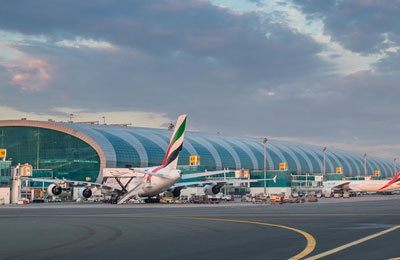
Dubai International Airport ...top-class connectivity.
Dubai sees huge tourism potential from GCC, Mena
DUBAI, May 14, 2015
The GCC and Mena regions present significant potential growth markets for Dubai tourism, despite already accounting for a combined 33 per cent of the emirate’s total visitor numbers.
Speaking this week on the sidelines of the United Nations World Tourism Organisation (UNWTO) Ministerial Forum on Intra-Arab Tourism, Helal Saeed Almarri, director general of Dubai’s Department of Tourism and Commerce Marketing (Dubai Tourism), highlighted the importance of the two regions to Dubai’s tourism economy, and outlined key reasons why they remain central to Dubai’s plans for increasing overall visitor numbers.
“Intra-Arab tourism has been of fundamental importance to the sustained growth of Dubai’s tourism economy over the past two decades. In 2014, 22 per cent of international visitors to Dubai came from GCC markets, and 11 per cent from other countries within the Middle East and North Africa. However, there is still significant potential to increase visitation, thanks to the connectivity provided by Dubai Airports and our home airlines, Emirates and flydubai, the visa policies of the United Arab Emirates, and the range of hotels, attractions and events which appeal to travellers from the regions.”
Of Dubai’s 13.2 million international overnight visitors in 2014, 2.98 million were drawn from GCC countries – an increase of 12.4 per cent on 2013 – and 1.55 million came from non-GCC countries in the Mena region – an increase of 18.1 per cent.
The forum gathered public and private sector leaders from across the Mena region and GCC to discuss co-operation between nations to increase intra-Arab tourism. A key focus was on increasing connectivity and improving ease of travel by relaxing visa policies.
Almarri stated that these did not pose particular challenges for Dubai. “Connectivity – regionally and globally – is one of the main reasons for the success of Dubai’s tourism industry – a fact underpinned by Dubai International Airport becoming the world’s busiest for international passengers in 2014 and last week’s announcement by Dubai Airports that the current capacity of six million passengers a year at Dubai World Central will be expanded to 26 million by 2017.
“Our home airlines, Emirates and flydubai, bring millions of passengers a year to Dubai from across the GCC and Mena regions, and these are supplemented by routes operated by many other regional airlines. The expectation of more open skies policy across the region will increase supply of seats to meet the demand. Once implemented across the region, our airlines would have more slots and – complemented by the introduction of larger aircraft and the emergence of more low-cost airlines – we’d be in a similar situation to other continents where regional residents are able to fly to neighbouring countries at a reasonable cost. This would clearly enhance visitor growth.
“With regards to ease of access, the UAE’s visa policies mean that visitors from the GCC do not require visas to visit Dubai, and there are streamlined processes in place which make Dubai highly accessible for other guests. This is no doubt a significant contributing factor to high visitation from our fellow Arab nations, as is the destination offer that has been formed by close collaboration between the government of Dubai and our partners in the private sector. Dubai’s focus on family tourism means that our destination offering is a perfect fit for this market. We already offer a diverse number of family attractions, hotels and experiences, and with more in the pipeline, alongside continued marketing and promotional efforts from both the private and public sector, we expect to make further inroads into these regional markets.”
The Cruise Arabia initiative was applauded as a great example of how regional neighbours are working to complement each other rather than compete against each other.
As an alliance formed between Dubai Tourism, The Oman Ministry of Tourism (Oman Tourism) and Abu Dhabi Tourism & Culture Authority, along with its newest partners Qatar Tourism Authority and Sharjah Commerce and Tourism Development Authority, Cruise Arabia’s growing alliance works as a unified partnership to develop strategies that enhance cruise line and cruise visitors’ experiences in the region.
“The main advantage of Cruise Arabia is that it creates a dialogue and allows the private sector to interact,” said Almarri. “We need to encourage every opportunity for the private sector to thrive – as it does in Dubai. If we give it support and encouragement it will drive tourism. More examples of this kind of regional co-operation are welcomed.” - TradeArabia News Service







